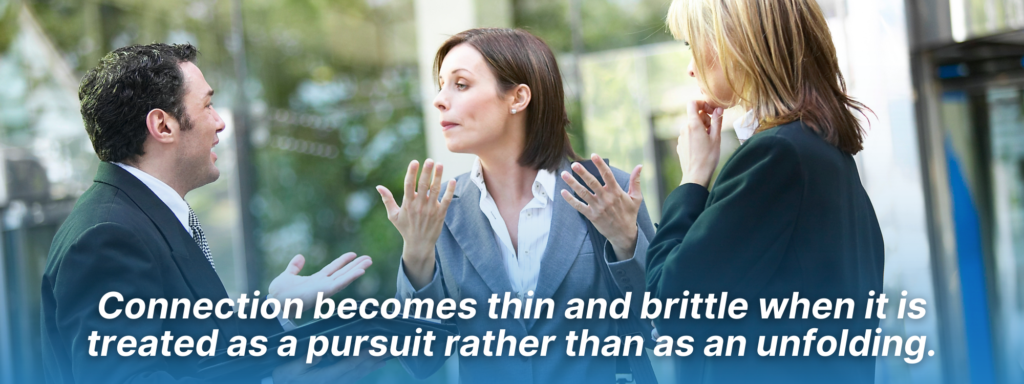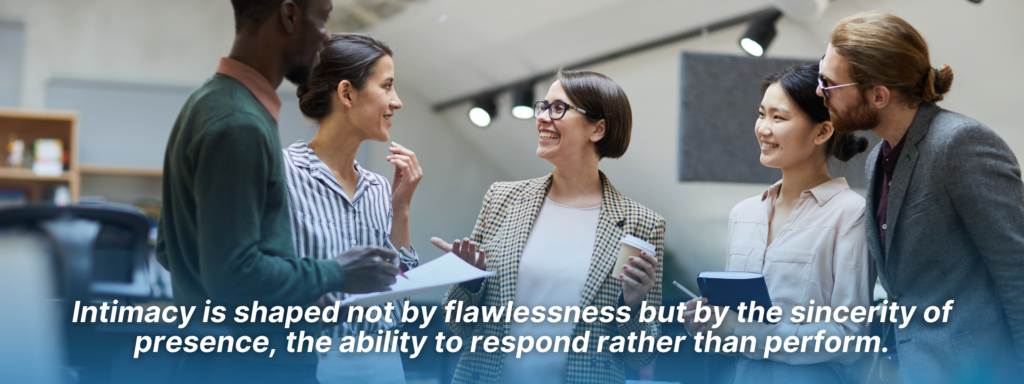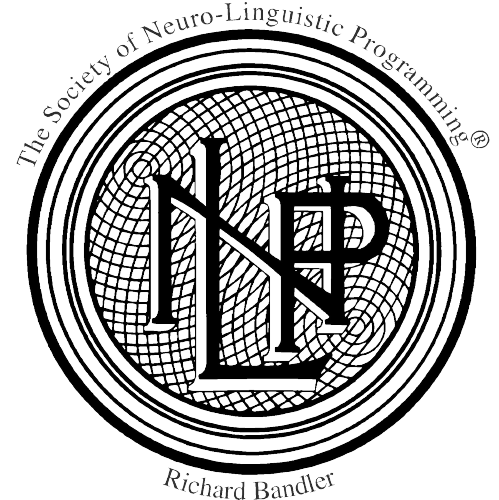The Art of Rapport
Intimacy, at its best, is neither a formula nor a transaction. It is not a checklist of technical competencies or a mechanical sequence of actions. It is an art—one shaped as much by presence as by movement, as much by listening as by expression. And like any great art, it is mastered not by force or by routine, but by rapport.
To attune is to notice the subtle: the flicker of hesitation, the deepening of breath, the quiet signals that suggest not only desire but trust, comfort, and play. Too often, discussions of intimacy are reduced to performance—how to be more confident, more skilled, more effective. Yet, effectiveness in this domain is a paradox. Many assume that mastery in intimacy is about technique, precision, or performance, as though it can be perfected like a skill.
But true connection resists rigid frameworks; the more one treats it as a formula to be optimised, the more mechanical and detached it becomes. Instead, intimacy flourishes in the spaces between intention and spontaneity, where presence overrides performance and responsiveness eclipses routine. The harder one tries to master it in the way one might master a golf swing or a soufflé, the more it eludes.
Mastery in intimacy is not about precision or technique, but about presence. The pursuit of control often leads to detachment, whereas true connection emerges from responsiveness and rapport. One cannot dominate connection; one must instead step into it, responsive and attuned, much like a musician improvising with a partner.
And therein lies the invitation: to move beyond the rigid notion of ‘good at’ intimacy and into a more intriguing space—the space of presence. The very best experiences do not arise from a scripted plan but from a shared moment of exploration, a conversation not only of words but of rhythms, touch, and unspoken understandings. The question, then, is not ‘How do I improve?’ but ‘How do I listen better?’

The Subtle Science
If intimacy is an art, then its medium is attention. Not the kind of attention that waits for an opening to act, nor the anxious hyper-awareness that seeks approval, but a richer, deeper form—the attention that dissolves self-consciousness and allows for genuine connection.
It is curious how frequently people believe that intimacy is driven by instinct, as though human connection is an automatic process requiring no thought, no refinement. Instinct may spark interest, but left untended, it does little to sustain. A fleeting glance across a room might create an initial charge, but without engagement, it fizzles into a momentary flicker. Contrast this with the quiet depth of a relationship where connection is nurtured—where attention, patience, and curiosity transform attraction into something lasting and profound. It is much like planting a seed and assuming it will grow without water, sunlight, or care.
A fleeting attraction might ignite the initial spark, but without attention and refinement, it withers into mere habit or fades into disinterest. Attention, on the other hand, refines. It slows down perception, tunes into nuance, and reveals a world that instinct alone cannot access. Imagine a dancer whose every movement is dictated by raw impulse rather than by the music or the partner’s presence. The result would not be harmony but chaos. Likewise, intimacy thrives not through instinct alone but through a cultivated awareness, a conscious decision to meet another where they are.
There is a reason that great poets and philosophers have long used music, conversation, and storytelling as metaphors for intimacy. In each of these, there exists a fundamental truth: that the most exquisite moments arise not from performance but from response. A conversation falters when one person speaks without listening; music fails when one musician plays without regard for the other. Similarly, connection becomes thin and brittle when it is treated as a pursuit rather than as an unfolding.
This shift—from instinct to rapport—transforms intimacy from something that happens to something that is shaped, sculpted, and mutually composed. And it is precisely this shift that invites curiosity rather than expectation, presence rather than pressure, and ultimately, connection rather than mere proximity.
The Language of Presence

In the most powerful moments of human connection, words often become secondary. This is not to say they are unnecessary—only that they are not the foundation upon which intimacy is built. Much like a great novel or a masterful piece of theatre, the power lies not only in what is said but in how it is said, in the pauses, the silences, the subtleties that shape meaning far more than the words themselves.
Presence is the language beneath language. It is the difference between the distracted nod of someone half-listening and the unwavering gaze of someone fully immersed in the moment. A storyteller knows that silence can be as powerful as words, just as a musician understands that the space between notes creates the rhythm. So too in intimacy—presence fills the gaps, making even the smallest gestures profound.
It is the quiet certainty that one is being seen, understood, and welcomed. In intimacy, this is the difference between mere contact and profound connection. One can follow all the so-called ‘rules’ of engagement—saying the right things, touching in the right ways, doing all that is expected—and yet still find something missing. Conversely, one can say little, do little, and yet leave an encounter feeling as though an entire world has been exchanged. The difference is presence.
To be present is not simply to be physically there; it is to bring one’s full attention to another, to set aside the internal noise of self-evaluation, anticipation, and doubt. It is to notice rather than assume, to feel rather than to act by habit. There is no need for grand gestures when presence itself can transform the simplest moments into something extraordinary. A single touch, given with full awareness, can say more than a thousand words spoken absentmindedly.
This is where intimacy truly begins—not in elaborate plans or in rehearsed confidence, but in the ability to pause, to witness, and to meet another in the ever-shifting dialogue of connection.
The Role of Allure
The finest connections, like the most captivating stories, hold a certain sense of mystery. Not the ambiguity that confuses or distances, but the gradual unveiling of understanding—the kind that deepens curiosity and draws one further in. True intimacy is not about revealing everything at once, but about unfolding in layers, allowing discovery to build anticipation and trust. Not the kind that creates uncertainty or detachment, but the kind that nurtures curiosity, encouraging a gradual unfolding rather than an immediate resolution. To reduce intimacy to a fixed script is to drain it of its vitality, for at its heart lies the thrill of unfolding, the delight of the unknown.
Playfulness, often underestimated, is an essential ingredient in this equation. It is through play that tension is lightened, that exploration is welcomed without fear of failure. A well-placed pause, a moment of teasing restraint, the gentle tug of anticipation—each of these serves as an unspoken invitation, a reminder that intimacy flourishes not in certainty but in shared adventure.
Consider the art of conversation. The best dialogues are those where one does not merely wait for a turn to speak but delights in the interplay, the rhythm, the unexpected turns. The same holds true for intimacy. Anticipation is not simply about waiting; it is about savouring the moment before the moment, about allowing connection to breathe rather than rushing to its conclusion.
Weaving Motion

If connection is an art and attention its medium, then movement—whether physical, emotional, or conversational—is its brushstroke. The best dancers do not move in isolation; they move in response, adjusting, leading, following, creating something that neither could achieve alone. Intimacy, too, is a dance, one in which responsiveness takes precedence over routine.
The tendency to focus on performance—on doing things ‘right’—often blinds people to the simple truth that what matters is not perfection but presence. Many default to this mindset because cultural narratives and societal expectations emphasise competence and achievement over connection. From an early age, people are taught to measure success by outcomes, whether in education, work, or relationships. This conditioning fosters a results-driven mindset, often at odds with the organic, unfolding nature of intimacy.
Unlike structured achievements, true connection resists metrics and thrives in presence, responsiveness, and the willingness to explore without a predetermined outcome. Yet, in intimacy, success is not about control or execution but about responsiveness, adaptability, and a willingness to engage in the unfolding moment. A dance executed flawlessly but without heart will never move its audience. Likewise, an interaction that follows every rule yet lacks genuine engagement will remain hollow. Instead, the question to ask is: how does one move with another, not just alongside them?
This responsiveness, this fluidity, is what makes connection feel alive. It is in the small, unscripted moments—laughter shared at an unexpected turn, the comfort of silence held without urgency—that true depth is found. The measure of a great dance is not in technical precision but in the feeling it evokes. A perfectly executed step sequence can be cold and mechanical if not infused with emotion, while an imperfect yet expressive movement can captivate and connect. Likewise, intimacy is shaped not by flawlessness but by the sincerity of presence, the ability to respond rather than perform. The same is true for intimacy.
The Quiet Echo
Ultimately, the most meaningful moments are not the ones meticulously planned or grandly executed but the ones that linger, that leave a quiet echo long after they have passed. To connect deeply with another is not to master a series of techniques, nor is it to aim for perfection. It is to be there fully, to listen with more than one’s ears, to respond with more than one’s words.
In the end, intimacy is not about knowledge or skill alone; it is about presence. And in a world so often rushing to the next moment, perhaps the greatest act of connection is simply to pause, to notice, and to meet another in the unfolding of now.



